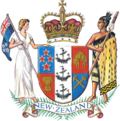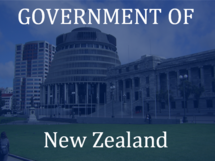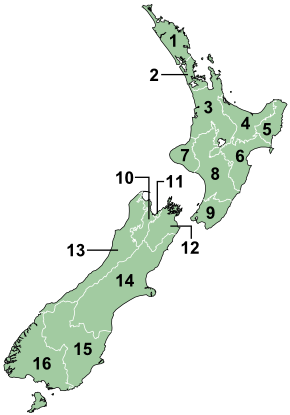Parliament of New Zealand
| Parliament of New Zealand | |
| 49th New Zealand Parliament | |
 |
|
| Type | |
|---|---|
| Type | Unicameral |
| Houses | House of Representatives |
| Leadership | |
| Speaker of the House of Representatives | Lockwood Smith, National Party since 9 December, 2008 |
| Leader of the House of Representatives | Gerry Brownlee, National Party since 9 December, 2008 |
| Structure | |
| Members | 120 Representatives |
| Election | |
| Meeting place | |
| Parliament House, Wellington, New Zealand | |
| Web site | |
| www.parliament.nz/en-NZ | |
The Parliament of New Zealand consists of the Queen of New Zealand and the New Zealand House of Representatives and, until 1951, the New Zealand Legislative Council. However most people incorrectly refer to the House of Representatives as 'Parliament'. The House of Representatives usually consists of 120 Members of Parliament (MPs), sometimes more due to overhang seats. MPs are directly elected by universal suffrage. New Zealand essentially follows the Westminster system of government, and is governed by a cabinet and Prime Minister chosen by the House of Representatives.
Parliament is physically located in Wellington, the capital city of New Zealand since 1865.
Contents |
History
The Parliament was established by the British New Zealand Constitution Act 1852 which established a bicameral legislature, but the upper house, the Legislative Council, was abolished in 1951 so the legislature is now unicameral. Parliament received full control over all New Zealand affairs in 1947 with the passage of the Statute of Westminster Adoption Act.
Country Quota
One historical specialty of the New Zealand Parliament was the Country Quota, which gave greater representation to rural politics. From 1889 on (and even earlier in more informal forms), districts were weighted according to their urban/rural split (with any locality of less than 2,000 people considered rural). Those districts which had large rural proportions received a greater number of nominal votes than they actually contained voters - as an example, in 1927, Waipawa, a district without any urban population at all, received an additional 4,153 nominal votes to its actual 14,838 - having the maximum factor of 28% extra representation. The country quota was in effect until it was abolished in 1945 by a mostly urban-elected Labour government, which went back to a one voter, one vote system.[1]
Sovereignty
| New Zealand | |
 This article is part of the series: |
|
|
|
|
|
Executive (The Crown)
Legislative (Parliament)
Elections
General
|
|
|
Other countries · Atlas |
|
The New Zealand Parliament is sovereign with no institution able to over-ride its decisions. The ability of Parliament to act is, legally, unimpeded. The New Zealand Bill of Rights Act is a normal piece of legislation, it is not superior law. Parliament is limited in extending its term, deciding on who can vote, how they vote (via secret ballot), how the country should be divided into electorates, and the make up of the Representation Commission which decides on these electorates. These issues require either 75% of all MPs to support the bill or a referendum on the issue. The entrenchment of these provisions was done through a normal Act of Parliament however.
Houses
New Zealand House of Representatives
The New Zealand House of Representatives has been the New Zealand Parliament's sole chamber since 1951. It is democratically elected every three years, with eighteen select committees to scrutinise legislation.
Upper house
The New Zealand Parliament does not have an upper house; it is unicameral rather than bicameral. There was an upper house up to 1950, and there have been occasional suggestions to create a new one.
Legislative Council
The Legislative Council was intended to scrutinize and amend bills passed by the House of Representatives, although it could not initiate legislation or amend money bills. Despite occasional proposals for an elected Council, Members of the Legislative Council (MLCs) were appointed by the Governor, generally on the recommendation of the Prime Minister. At first, MLCs were appointed for life, but a term of seven years was introduced in 1891. It was eventually decided that the Council was having no significant impact on New Zealand's legislative process, and the terms of its members expired on 31 December 1950. At the time of its abolition it had fifty-four members, including its own Speaker.
Senate proposal
The National government of Jim Bolger proposed the establishment of an elected Senate when it came to power in 1990, thereby reinstating a bicameral system, and a Senate Bill was drafted. Senators would be elected by STV, with a number of seats being reserved for Māori, and would have powers similar to those of the old Legislative Council. The House of Representatives would continue to be elected by FPP.
The intention was to include a question on a Senate in the second referendum on electoral reform. Voters would be asked, if they did not want a new voting system, whether or not they wanted a Senate.[1] However, following objections from the Labour opposition, which derided it as a red herring, and other supporters of MMP, the Senate question was removed by the Select Committee on Electoral Reform, and the issue has not been pursued since.
Passage of legislation
The New Zealand Parliament's model for passing Acts of Parliament is similar (but not identical) to that of other Westminster System governments.
Laws are initially proposed in Parliament as bills. They become Acts after being approved three times by Parliamentary votes and then receiving Royal Assent from the Governor-General. The majority of bills are promulgated by the government of the day (that is, the party or parties that have a majority in Parliament). It is rare for government bills to be defeated, indeed the first to be defeated in the twentieth century was in 1998. It is also possible for individual MPs to promote their own bills, called member's bills; these are usually put forward by opposition parties, or by MPs who wish to deal with a matter that parties do not take positions on.
House of Representatives
- Further information: New Zealand House of Representatives#Passage of legislation
Within the House of Representatives, bills must pass through three readings and be considered by both a Select Committee and the Committee of the Whole House.
Royal Assent
- Further information: Royal Assent#New Zealand
If a Bill passes its third reading, it is passed by the Clerk of the House of Representatives to the Governor-General, who will (assuming constitutional conventions are followed) grant Royal Assent as a matter of course. Some constitutional lawyers, such as Professor Philip Joesph, believe the Governor-General does retain the power to refuse Royal Assent to Bills in exceptional circumstances - specifically if democracy is to be abolished[2]. Others, such as former law professor and Prime Minister Sir Geoffrey Palmer and Matthew Palmer argue any refusal of Royal Assent would lead to a constitutional crisis[3]. Refusal of Royal Assent has never occurred under any circumstances in New Zealand.
Once Royal Assent has been granted, the Bill then becomes law.
Terms of Parliament
Parliament is currently in its 48th term.
| Term | Elected in | Government |
|---|---|---|
| 1st Parliament | 1853 election | No Parties |
| 2nd Parliament | 1855 election | No Parties |
| 3rd Parliament | 1860 election | No Parties |
| 4th Parliament | 1866 election | No Parties |
| 5th Parliament | 1871 election | No Parties |
| 6th Parliament | 1875 election | No Parties |
| 7th Parliament | 1879 election | No Parties |
| 8th Parliament | 1881 election | No Parties |
| 9th Parliament | 1884 election | No Parties |
| 10th Parliament | 1887 election | No Parties |
| 11th Parliament | 1890 election | First Liberal |
| 12th Parliament | 1893 election | |
| 13th Parliament | 1896 election | |
| 14th Parliament | 1899 election | |
| 15th Parliament | 1902 election | |
| 16th Parliament | 1905 election | |
| 17th Parliament | 1908 election | |
| 18th Parliament | 1911 election | Reform |
| 19th Parliament | 1914 election | |
| 20th Parliament | 1919 election | |
| 21st Parliament | 1922 election | |
| 22nd Parliament | 1925 election | |
| 23rd Parliament | 1928 election | United |
| 24th Parliament | 1931 election | United-Reform Coalition |
| 25th Parliament | 1935 election | First Labour |
| 26th Parliament | 1938 election | |
| 27th Parliament | 1943 election | |
| 28th Parliament | 1946 election | |
| 29th Parliament | 1949 election | First National |
| 30th Parliament | 1951 election | |
| 31st Parliament | 1954 election | |
| 32nd Parliament | 1957 election | Second Labour |
| 33rd Parliament | 1960 election | Second National |
| 34th Parliament | 1963 election | |
| 35th Parliament | 1966 election | |
| 36th Parliament | 1969 election | |
| 37th Parliament | 1972 election | Third Labour |
| 38th Parliament | 1975 election | Third National |
| 39th Parliament | 1978 election | |
| 40th Parliament | 1981 election | |
| 41st Parliament | 1984 election | Fourth Labour |
| 42nd Parliament | 1987 election | |
| 43rd Parliament | 1990 election | Fourth National |
| 44th Parliament | 1993 election | |
| 45th Parliament | 1996 election | Fourth National (in coalition) |
| 46th Parliament | 1999 election | Fifth Labour (in coalition) |
| 47th Parliament | 2002 election | |
| 48th Parliament | 2005 election | |
| 49th Parliament | 2008 election | Fifth National (in coalition) |
See also
- New Zealand Parliament Buildings
- Constitution of New Zealand
- Independence of New Zealand
References
- ↑ McKinnon, Malcolm (ed.) (1997). New Zealand Historical Atlas. David Bateman. p. plate 90.
- ↑ Philip Joseph (2002). Constitutional and Administrative Law in New Zealand (2nd edition ed.). Brookers. ISBN 9780864723994.
- ↑ Sir Geoffrey Palmer and Matthew Palmer (2004). Bridled Power: New Zealand's Constitution and Government (4th edition ed.). Oxford University Press. ISBN 0195584635.
External links
|
||||||||||||||||||||||||||

